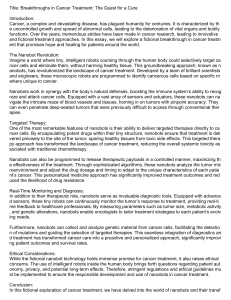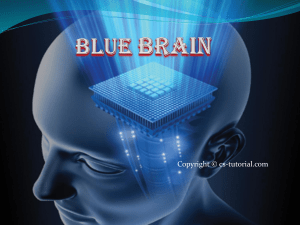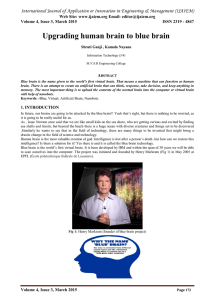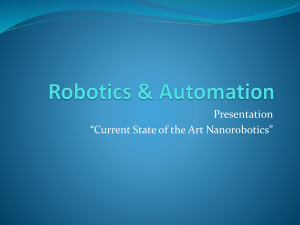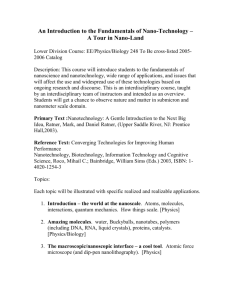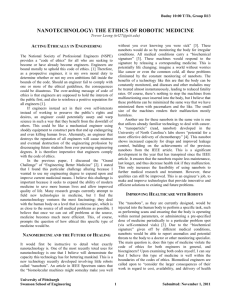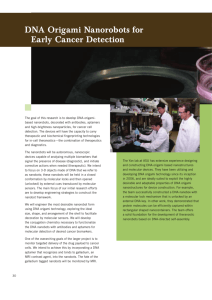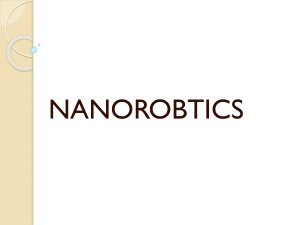Nanobots: The Future Of Medical Treatments
advertisement
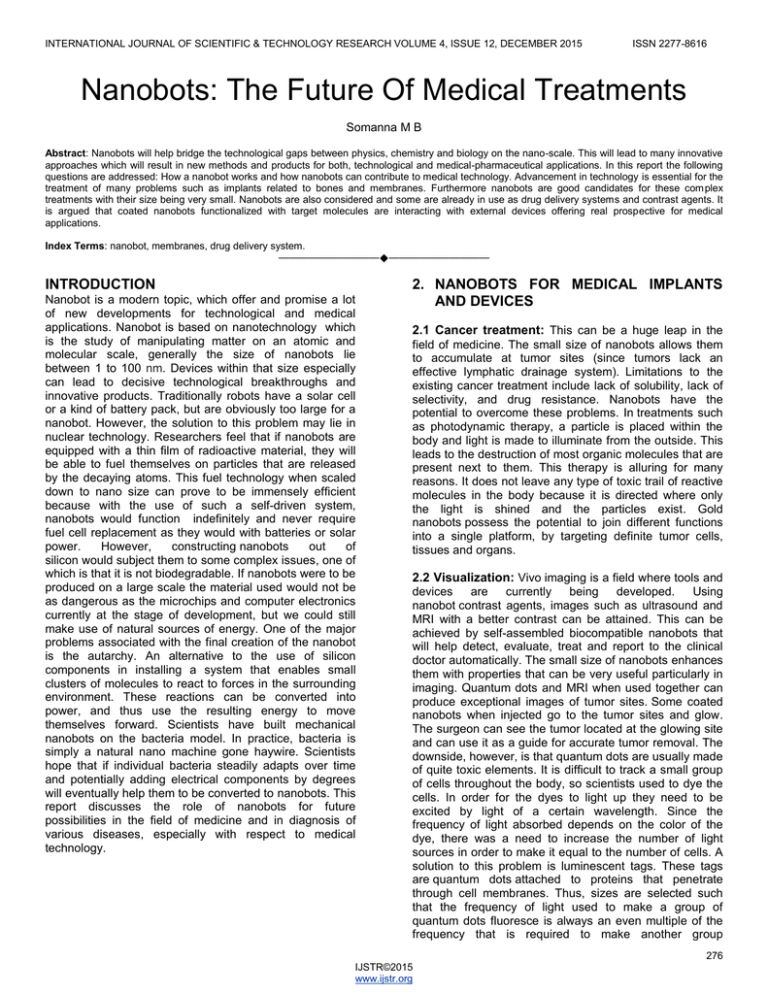
INTERNATIONAL JOURNAL OF SCIENTIFIC & TECHNOLOGY RESEARCH VOLUME 4, ISSUE 12, DECEMBER 2015 ISSN 2277-8616 Nanobots: The Future Of Medical Treatments Somanna M B Abstract: Nanobots will help bridge the technological gaps between physics, chemistry and biology on the nano-scale. This will lead to many innovative approaches which will result in new methods and products for both, technological and medical-pharmaceutical applications. In this report the following questions are addressed: How a nanobot works and how nanobots can contribute to medical technology. Advancement in technology is essential for the treatment of many problems such as implants related to bones and membranes. Furthermore nanobots are good candidates for these complex treatments with their size being very small. Nanobots are also considered and some are already in use as drug delivery systems and contrast agents. It is argued that coated nanobots functionalized with target molecules are interacting with external devices offering real prospective for medical applications. Index Terms: nanobot, membranes, drug delivery system. ———————————————————— INTRODUCTION Nanobot is a modern topic, which offer and promise a lot of new developments for technological and medical applications. Nanobot is based on nanotechnology which is the study of manipulating matter on an atomic and molecular scale, generally the size of nanobots lie between 1 to 100 nm. Devices within that size especially can lead to decisive technological breakthroughs and innovative products. Traditionally robots have a solar cell or a kind of battery pack, but are obviously too large for a nanobot. However, the solution to this problem may lie in nuclear technology. Researchers feel that if nanobots are equipped with a thin film of radioactive material, they will be able to fuel themselves on particles that are released by the decaying atoms. This fuel technology when scaled down to nano size can prove to be immensely efficient because with the use of such a self-driven system, nanobots would function indefinitely and never require fuel cell replacement as they would with batteries or solar power. However, constructing nanobots out of silicon would subject them to some complex issues, one of which is that it is not biodegradable. If nanobots were to be produced on a large scale the material used would not be as dangerous as the microchips and computer electronics currently at the stage of development, but we could still make use of natural sources of energy. One of the major problems associated with the final creation of the nanobot is the autarchy. An alternative to the use of silicon components in installing a system that enables small clusters of molecules to react to forces in the surrounding environment. These reactions can be converted into power, and thus use the resulting energy to move themselves forward. Scientists have built mechanical nanobots on the bacteria model. In practice, bacteria is simply a natural nano machine gone haywire. Scientists hope that if individual bacteria steadily adapts over time and potentially adding electrical components by degrees will eventually help them to be converted to nanobots. This report discusses the role of nanobots for future possibilities in the field of medicine and in diagnosis of various diseases, especially with respect to medical technology. 2. NANOBOTS FOR MEDICAL IMPLANTS AND DEVICES 2.1 Cancer treatment: This can be a huge leap in the field of medicine. The small size of nanobots allows them to accumulate at tumor sites (since tumors lack an effective lymphatic drainage system). Limitations to the existing cancer treatment include lack of solubility, lack of selectivity, and drug resistance. Nanobots have the potential to overcome these problems. In treatments such as photodynamic therapy, a particle is placed within the body and light is made to illuminate from the outside. This leads to the destruction of most organic molecules that are present next to them. This therapy is alluring for many reasons. It does not leave any type of toxic trail of reactive molecules in the body because it is directed where only the light is shined and the particles exist. Gold nanobots possess the potential to join different functions into a single platform, by targeting definite tumor cells, tissues and organs. 2.2 Visualization: Vivo imaging is a field where tools and devices are currently being developed. Using nanobot contrast agents, images such as ultrasound and MRI with a better contrast can be attained. This can be achieved by self-assembled biocompatible nanobots that will help detect, evaluate, treat and report to the clinical doctor automatically. The small size of nanobots enhances them with properties that can be very useful particularly in imaging. Quantum dots and MRI when used together can produce exceptional images of tumor sites. Some coated nanobots when injected go to the tumor sites and glow. The surgeon can see the tumor located at the glowing site and can use it as a guide for accurate tumor removal. The downside, however, is that quantum dots are usually made of quite toxic elements. It is difficult to track a small group of cells throughout the body, so scientists used to dye the cells. In order for the dyes to light up they need to be excited by light of a certain wavelength. Since the frequency of light absorbed depends on the color of the dye, there was a need to increase the number of light sources in order to make it equal to the number of cells. A solution to this problem is luminescent tags. These tags are quantum dots attached to proteins that penetrate through cell membranes. Thus, sizes are selected such that the frequency of light used to make a group of quantum dots fluoresce is always an even multiple of the frequency that is required to make another group 276 IJSTR©2015 www.ijstr.org INTERNATIONAL JOURNAL OF SCIENTIFIC & TECHNOLOGY RESEARCH VOLUME 4, ISSUE 12, DECEMBER 2015 incandesce. Then both groups can be lit using a single light source. They have also found a way to insert these nanobots into the affected parts of the body. 2.3 Administration of biomolecules and cells: Nanobots have found many applications including cell separation and probing. Magnetic particles are mostly spherical, which somewhat limits the possibilities to make these nanobots multifunctional. On the other hand cylindrically shaped nanobots can be created by employing metal electrode position into non-porous alumina template. Depending on the characteristics of the template, the range the radius of the nano-cylinders can be selected from 5 to 500 nm while their length can be as big as 60 μm. By sequentially depositing various metals of different thicknesses, the magnetic properties and the structure of individual cylinders can be varied as per requirement. Thus, nanowires with spatially segregated fluorescent parts can be produced. The large aspect ratios can cause the residual magnetization of these nanowires to be high. Hence, weaker magnetic field can be used to drive the nanowires. It has been shown that a magnetic nanowires using self-assembly technique in suspension can be controlled by weak external magnetic fields. Cell assembly in different shapes and forms can thus be controlled. Moreover magnetic trapping could be used. 2.4 Detection of proteins: Proteins act as an important part of the cell's language, machinery and structure. Understanding their properties is very important for further progress in the field of medicine. Gold nanoparticles are widely used in the field of chemistry to identify proteinprotein interaction. Spectroscopy with Surface-enhanced Raman scattering is a technique that is widely used for detection and identification of molecules that possess single dye. By combining these two techniques in a single nanobot probe one can drastically improve the multiplexing capabilities of protein probes. 2.5 Sensing: Here magnetic nanobots, bound to a suitable antibody, are used to label specific structures, molecules or microorganisms. Detection of genetic sequence in a sample can be done using gold nanoparticles tagged with short segments of DNA. Sensor test chips contain thousands of nanowires that help in the detection of proteins and other biomarkers that are left behind by cancer cells may help enable the detection and diagnosis of cancer in the early stages. Nanobots are helping advance the use of arthroscopes, which are used in surgeries so that surgeons can do the surgeries by making very small incisions. The smaller is the incision the faster is the healing time and the better it is for the patients. 2.6 Tissue engineering: Nanobots could be used in tissue engineering to help reproduce or repair damaged tissue using suitable nanomaterial-based growth factors and scaffolds. Tissue engineering if successful may replace conventional treatments like artificial implants or organ transplants. Nanoparticles such as carbon nanotubes, graphene, molybdenum disulfide and tungsten disulfide are being integrated into nanobots as reinforcing agents. Potentially, these nano-composites may be used ISSN 2277-8616 as a best replacement, light weight, mechanically strong composite for bone implants. 2.7 Medical device: Neuro-electronic interfacing is a visionary goal that deals with the construction of nanodevices that will permit computers to be linked to the nervous system. This idea requires the development of a molecular structure that will enable control and detection of nerve impulses by an external computer. The application of a refuelable strategy implies that energy is refilled periodically with external sonic, chemical or biological electrical sources. While a non-refuelable strategy implies that all power is drawn from internal energy that is stored and would stop when the energy is completely drained out. A nanoscale biofuel cell for selfpowered nano-devices has been developed that uses glucose from bio-fluids including human blood and watermelons. One limitation to this innovative strategy is the electrical interference or leakage or the problem of overheating from power consumption is possible. The wiring that needs to be done for the structure is extremely difficult because they must be positioned with extreme precision in the nervous system. It is very important to ensure that interface provided by the structures must also be compatible with the body's immune system. Molecular nanotechnology is a conjectural subfield of nanotechnology regarding the possibility that machines could re-order matter at a molecular or atomic scale. Nano-medicine would make use of these nanobots, introduced into the body, to repair or detect damages and infections. The topic of molecular nanotechnology is highly theoretical that seeks to anticipate what inventions nanotechnology could yield and to put forth an agenda for future inquiry. The proposed elements of molecular nanotechnology, such as molecular assemblers and nanobots are far beyond current capabilities. Fig 1: Principle of apheresis with a nanoporous hollow fibre membrane. 3. NANOBOTS AND THEIR FUNCTIONAL PROPERTIES Nanobots are used and further developed for the separation and labeling of biological samples. In this way they are an important component for a variety of bioanalytical methods In addition a lot of different types of organic and inorganic nanoparticles (sec [1] and references therein) can help to overcome crucial problems associated with diagnosis and therapy. Those problems are (1) the poor solubility and instability of certain drugs, (2) the transport of non-resistant therapeutic biomaterials, 277 IJSTR©2015 www.ijstr.org INTERNATIONAL JOURNAL OF SCIENTIFIC & TECHNOLOGY RESEARCH VOLUME 4, ISSUE 12, DECEMBER 2015 (3) the lack of controllable release and selective enrichment of drugs and contrast agents in the region of interest, (4) the crossing of biological barriers like cell membranes and the blood brain barrier. Nanobots can be used as a drug delivery system to cross this biological barrier. One approach uses polymer based nanobots that are loaded with doxorubien and coated with polysorbate. This coating is used to absorb blood a special type of protein from the blood and finally the loaded nanobot gets access to the brain. Promising results have been achieved in the recent experiments conducted on rats in order to combat glioblastomas [2]. Magnetic nanobots are good candidates for new and innovative diagnosis and therapy. They are already in use for MRI and there other fields of application that is still under development, which use magnetic fields to control or to heat the particles [3, 4 and references therein]. Not only can magnetic nanobots be heated or activated by external devices but also gold nanoparticles use their strong near infrared absorption: they are enriched in a tumor, heated by laser and thereafter the tumor tissue can be destroyed [5]. ISSN 2277-8616 5. REFERENCES [1] Wagner V and Wechsler D, "Nano biotechnology II: Anwendungen in der Medicine and Pharmacies", u n tie technology in 50, VDI Technologiezentrum (Ed.), ISSN 14365928,2004. [2] Steiniger S. C, "Chemotherapy of Glioblastoma in rats using doxorubicin-loaded nanoparticles", nt. Cancer, 109, pp. 759 - 767, 2004. [3] Berry. C. C, and Curtis A. S. G, "Functionalization of magnetic nanoparticles for application in biomedicine", h s. Al.hs.36,pp.R198-R206,2003. [4] Gould P., "Nanoparticles probe bio-systems", materials toapply (36-43), Feb.2004. [5] O'Neal D. P. et al., "Photo-thermal tumor ablation in mice using near infrared-absorbing nanoparticles", Cancer letters, 209(2), pp.171176, 2004. Fig 2: Illustration of possible functional properties of a nanoparticle. It can be equipped with target molecules and coated ( for suitable biointeraction, biocompatibility, additional properties), loaded ( with drugs or other useful material), and stimulated by technical devices or by specific biomolecules in the target tissue (to release the load, move or hold the particle, heat the nano-object, deliver or influence a signal which is detected by an external device). 4. OUTLOOK As has been show, nanobots can contribute significantly to the advancements in the field of medicine in many different ways. Apart from the above mentioned applications there are other fields such as targeted drug delivery. Further developments in this field will lead to breakthrough in various other important fields. From nano robotic systems one would expect the same capabilities, but they will not be realized as applicable tools in the foreseeable future. Although many scientific problems have to be solved, nanobots offers a comparatively promising perspective in therapy and diagnosis of various diseases. 278 IJSTR©2015 www.ijstr.org
